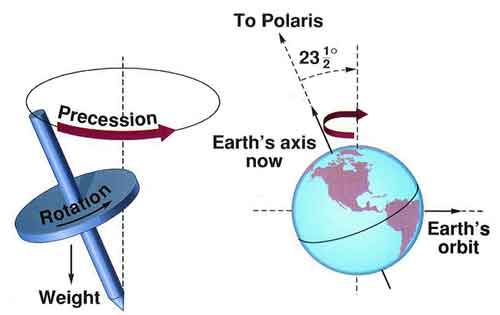Pergunta: O movimento de precessão da Terra é de 26000 anos. Ao fim desses anos todos volta tudo ao ponto de partida? O ângulo de inclinação do eixo da Terra de 23.5º altera-se também ou não? De que forma é que a precessão altera os equinócio? Ficam mais frios, mais quentes, mudam de sítio?
Resposta: Sim, ao fim de 26000 anos volta tudo ao ponto de partida. O ângulo de inclinação do eixo da Terra não se altera. O movimento é como o de um pião (ver figura). A inclinacão mantém-se sempre nos 23.5 graus. Aliás, se tal não fosse assim, as nossas estações desapareceriam, o nosso clima tornar-se-ia caótico e, provavelmente, as condições para a vida desapareceriam. A estabilidade do eixo é apontada como uma das razões fundamentais para a Terra ser tao propícia à vida.

Em termos práticos, por ser um processo tão lento (em cada ano a Terra só avança 1/26000 na rotação de precessão), nada do que mencionou é afectado (nem equinócios, nem temperaturas). O que "muda de sítio" é a localização dos polos celestes (na Esfera Celeste - uma projeçãoo da Terra num local imaginário do espaço), pois estes resultam da insterseção do prolongamento do eixo de rotação da Terra com a Esfera Celeste.
Question: The movement of precession of the Earth is 26000 years. At the end of all those years does everything go back to the starting point? Does the angle of inclination of the Earth’s áxis which is 23.5º also change? In what way does the precession change the equinox? Does it become colder, warmer, change position?
Answer: Yes, after 26000 years
everything goes back to the starting point. The angle of inclination of the
Earth’s axis does not change. The movement is similar to that of a
whipping-top (see the figure). The inclination always remains
at 23.5 degrees. Moreover, if it was not so, our seasons would disappear,
our climate would become chaotic and, most probably, the conditions for life
would disappear. The stability of the axis is considered one of the
fundamental reasons for Earth being so favourable to life.
In practical terms, because it is such a slow
process (each year the Earth only advances 1/26000 in the precession
rotation), nothing that you mentioned is affected (not equinoxes, nor
temperatures). What “chages position” is the localization of the celestial
poles (in the celestial sphere – a projection of the Earth in an imaginary
place in space), after all, this results from the intersection of the
continuation of Earth rotational áxis with the celestial sphere.
Respondido por / Answered by:
Pedro Augusto
(28-11-2008). Translated by: Angelino Gonçalves
(12-03-2012).
| > © 2008 Grupo de Astronomia da Universidade da Madeira |